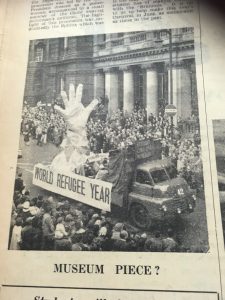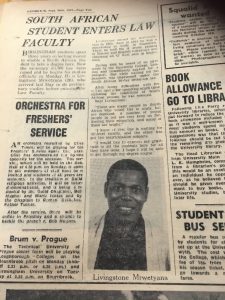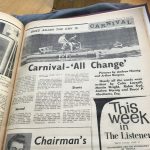An important aspect of this project was looking through old editions of Redbrick [the University’s student newspaper] in the Cadbury Research Library, to discover what political activities students were engaged in at this time. Student activity proved to be immensely varied, spanning from small local community projects to participation in large international campaigns. The majority of the local projects were funded by the annual Birmingham-wide ‘Carnival’. During the early 1960s Carnival was a huge affair, comprising of varied events such as balls, concerts and fancy dress, all in aid of local charities. The Carnival parade through the city centre was particularly popular, attracting crowds of students and local people alike. Some students built their floats to raise the profile of important causes, such as the 1968 float for World Refugee Year, where others took a more creative and abstract approach.

Outrageous stunts were also conducted to persuade people to donate to Carnival’s chosen causes, which included Birmingham Children’s Hospital, and Dodford’s Children’s Farm, which provided a holiday camp for inner-city Birmingham children. A particularly memorable stunt was the 1962 successful riding of a cunningly converted tandem bicycle across the Channel.
However, while these stunts were originally harmless activities in aid of local causes, they also contributed to the decline of Carnival in the late 1960s as they became increasingly out of control, and drew the focus away from Carnival’s real purpose. Carnival was saved from extinction by a full restructuring, which created a much more focused effort, with parades and stunts abandoned in favour of planning and executing local community projects. These included assisting an impoverished local widow with 13 children, and using Carnival proceeds to purchase a van to transport disabled inner-city children into the countryside. Carnival was a very successful avenue for charitable student activity on the local level, which has continued into the present day, evolving into the highly successful Carnival Rag.

Redbrick also exposed that students were involved in international campaigns, such as the Anti-Apartheid protests of the 1960s and 1970s. Like many Universities across Britain, the University of Birmingham had a South Africa Student Fund, which sponsored students excluded from education due to apartheid to study in the UK. However, the University of Birmingham was uniquely connected to issues in Southern Africa due to a longstanding partnership with University College, Salisbury, Rhodesia. As the Smith regime increasingly encroached on the rights and freedoms of students, Birmingham student activity escalated. They urged University authorities to do more to protect Rhodesian students, and reiterate that funding would be instantly withdrawn should the institution become segregated. They also held multiple protests in Birmingham city centre as part of a national campaign of opposition to the Smith regime.
However, the situation at University College, Rhodesia, continued to deteriorate. Restrictions increased, students were expelled and lecturers were deported. In 1966 it was decided that University of Birmingham support could no longer continue. However, Birmingham students remained involved, continuing the South African Student Fund, and remaining committed to the campus-wide ban on products sourced from South Africa.
Bryony Parsons, BA American Studies/History


